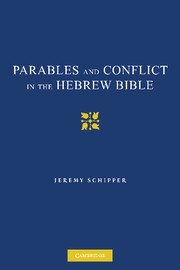Book contents
- Frontmatter
- Contents
- Preface
- Abbreviations
- 1 Breaking Down Parables: Introductory Issues
- 2 Devouring Parables: Jotham's Parabolic Curse in Judges 9
- 3 Overallegorizing and Other Davidic Misinterpretations in 2 Samuel 11–12
- 4 Changing Face and Saving Face: Parabolic Petitions in 2 Samuel 14
- 5 Grasping the Conflict: Ahab's Negotiation of Conflicts and Parables in 1 Kings 20
- 6 Intellectual Weapons: The Parable's Function in 2 Kings 14 and 2 Chronicles 25
- 7 Conclusions and Implications for the Study of Hebrew Bible Parables
- Notes
- Works Cited
- Scriptural and Extra-Biblical Texts Index
- General Index
1 - Breaking Down Parables: Introductory Issues
Published online by Cambridge University Press: 30 September 2009
- Frontmatter
- Contents
- Preface
- Abbreviations
- 1 Breaking Down Parables: Introductory Issues
- 2 Devouring Parables: Jotham's Parabolic Curse in Judges 9
- 3 Overallegorizing and Other Davidic Misinterpretations in 2 Samuel 11–12
- 4 Changing Face and Saving Face: Parabolic Petitions in 2 Samuel 14
- 5 Grasping the Conflict: Ahab's Negotiation of Conflicts and Parables in 1 Kings 20
- 6 Intellectual Weapons: The Parable's Function in 2 Kings 14 and 2 Chronicles 25
- 7 Conclusions and Implications for the Study of Hebrew Bible Parables
- Notes
- Works Cited
- Scriptural and Extra-Biblical Texts Index
- General Index
Summary
“[Parables in the Hebrew Bible] are not, even indirectly, appeals to be righteous. What is done is done, and now must be seen to have been done; and God's hostile action can be confidently pronounced.”
–M.D. Goulder, Midrash and Lection in Matthew“[A] first step when we fail with parables would be to structure the defeat, and to chart the contours of our ignorance.”
–John J. Bonsignore, “In Parables: Teaching through Parables”Nearly 40 years ago, if you asked a Hebrew Bible scholar to define the word “parable,” he or she would have most likely replied that it is a genre designation for a type of short story and that it comes from the biblical Hebrew word mashal (plural form: meshalim). He or she would have cited the story Nathan tells to David in 2 Sam 12:1–4 or Isaiah's song of the vineyard in Isa 5:1–7 as typical examples of this parable genre. For instance, in his influential 1967 article on the so-called juridical parable genre, Uriel Simon includes these texts among his examples (he also cites 2 Sam 14:5–7; 1 Kgs 20:39–42; Jer 3:1–5). Yet, in 1981, George W. Coats responds to Simon by correctly asking, “How can the story in II Samuel 12:1–4 and the song in Isaiah 5:1–7 belong to the same genre?” Coats’ question suggests that between the late 1960s and the early 1980s, a number of scholars had begun reconsidering how we should use the term parable (mashal).
- Type
- Chapter
- Information
- Parables and Conflict in the Hebrew Bible , pp. 1 - 22Publisher: Cambridge University PressPrint publication year: 2009



